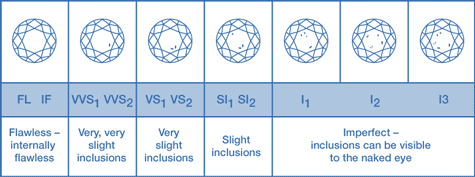Blog
A Guide to Diamond Clarity
12 October, 2016

When it comes to purchasing diamonds, you may become baffled by the different terms that pop up along the process. You may be familiar with the term the 'Four Cs' - this one is incredibly important in purchasing a family heirloom or an engagement ring for that special someone.
In the past we have shared tips of choosing diamond cuts, carat weights and coloured stones (find them here if you missed them!) - this week we're going to delve into the fourth C and share with you some useful advice on diamond clarity.
What is diamond clarity?
Most diamonds contain some inner flaws, or inclusions, that occur during the formation process. The visibility, number and size of these inclusions determine what is called the clarity of a diamond. Diamonds that are clear create more brilliance, and thus are more highly prized, and priced.
Because they are formed deep within the earth, under extreme heat and pressure; virtually all diamonds contain "birthmarks"; small imperfections inside the diamond (called inclusions), or on its surface (called blemishes). Clarity refers to the degree to which these imperfections are present. Diamonds which contain numerous or significant inclusions or blemishes have less brilliance because the flaws interfere with the path of light through the diamond.
How can diamond cutters enhance clarity?
The position of an inclusion affects how easily it can be seen. Diamond cutters make every effort to cut a stone so that inclusions are not visible through the table of the finished diamond. The preferred position for inclusions is under the bezel facets or near the girdle because they are harder to see there.
How is diamond clarity measured?
GIA Diamond Clarity Scale

The Radiant team can advise you on the best clarity to suit your requirements, design and budget - to find out more information, click here.

